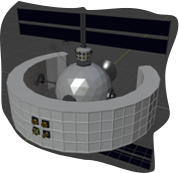Overview: Fundmental Technologies, LLC in cooperation with researchers at the University of California - Berkley, New Jersey Institute of Technology, and Columbia University have developed the Lagrange Communications Advanced Realtime Spaceweather (LCARS) Array Mission Concept. LCARS is a fleet of futuristic Spacecraft intended to provide realtime Interplanetary communications throughout the Solar System coupled with Advanced Instrumentation to monitor the Sun and Solar Wind.
Mission Concept Background: The LCARS Array Mission Concept was born out of a question asked by Dr. Nicola Fox at the 2020 NASA Heliophysics 2050 Workshop. Dr. Fox's question: "What should the state of Human exploration look like in the year 2050?". From that simple question our team started working on identifying what the state of space exploration should be by the year 2050. We utilized one of the most prolific Science Fiction visionaries to help answer our question, Mr. Gene Roddenberry. Mr. Roddenberry's vision of the Star-Trek universe provided a unique perspective on what future human exploration could eventually accomplish given centuries of scientific and engineering advance.
The Star-Trek Universe vision placed communication and research stations throughout this quadrant of our galaxy. While this is just one of many possible futures, our team asked the question "What would be the first steps to accomplish this vision?" We determined the most logical next step for human exploration would be to put large advanced even futuristic spacecraft at the five Earth-Sun Lagrange points. Each of the spacecraft would be comprised of two components, an advanced communications array and an advanced solar and spaceweather monitoring array. The five Lagrange Points are stable and semi-stable points in the Earth-Sun system that orbit at the same frequency as the Earth around the Sun. Descriptively, Lagrange point 1, or L1, is between the Earth and the Sun at the point where the gravitational pull from the Earth is exactly balance by the graviational pull from the Sun. There are many spacecraft already at this location including the SOHO telescope. L2 requires a bit more math as to why it is a stable point but it exists at a reflection point on the other side of the Earth along the Earth-Sun line. There are many spacecraft already at this point including the James-Webb Space Telescope. L3 is a point that is exactly on the other side of the Sun along the Earth-Sun line. L4 and L5 again require a lot more math to explain but they exist on the flanks of the Earth-Sun line, one to the left and one to the right, at about a 45 degree angle from the Earth-Sun line.
Why the LCARS Array: Data and Communications
- Data volume by current (and to be flown) NASA Heliophysics mission (or the NASA Heliophysics Fleet) has exploded exponentially heading into the 10's of TB/Day
- Currently, Instrument capabilities are severly hampered by bandwidth limitations even with modern compression algorithms (lossless or lossy).
- The NASA Deep Space Network (DSN) commuincations must prioritze time slices for each Mission / spacecraft
- DSN time slicing provides only approximately 3 hours of Voyager SC data/day/SC
- Potential important scientific discoveries have been missed because of time slicing
- New DSN antennae are exceptionally expensive in today's $'s, as expensive as the current estimate for a single LCARS spacecraft.
- DSN bandwidth is limited as we start working with 10's of TBs of data per day per SC
- High bandwidth Communications is very limited through the Earth's atmosphere which highly attenuates high bandwidth frequencies
- Recently tested Laser communications while successful in near Earth must be highly refined to handle Interplanetary pointing as well as diffusive effects on the laser beam over Astronomical distances of 1 AU or more.
Why the LCARS Array: Solar Science and Space Weather
- Modern Space weather observatories are limited in capability regarding instrumentation, bandwideth, temporal and spatial resolution, etc.
- e.g. STEREAO A/B system showed the effectiveness of a system observatory view of the sun from three different solar sectors (with ACE at L1)
- but STEREO had orbits that only worked for parts of the mission (Note: STEREO B is no longer functional as of 10/9/206)
- Solar Probe and Solar Orbiter are phenomenal missions providing discoveries behod their original mission concept studies
- but they can't see the "whole" sun all the time
- Space weather modeling accuracy demands a "whole" sun view allowing incrmental and sometimes significantly improvement in the ability to accurately predict times when Earth space assets are at risk as well as future Human assets in the solar system (Mars etc.). This is a National Security concern as well as a financial concern!!!
- There is critical need for highly accurate space weather predictions for human presence on the Moon and Mars since both bodies spend significant amount of time in the highly radioactive Solar Wind exposed to Space Weather without a magnetic shield.
Communications Payload: LCARS Spacecraft will be equiped with multi-frequency and multi-channel communications arrays coupled with Terahertz/Laser Comm systems for LCARS SC to LCARS SC communications. Additionally, the current LCARS concept includes a gimbled communications dish pointing into deep space and with all five LCARS spacecraft coupled together significantly enhances the existing NASA DSN. With all five LCARS spacecraft looking outward, the entirety of deep space can be viewed. This is impossible with the existing NASA DSN because the Earth can't "see" through the Sun to deep space on the other side of the Sun.
Scientific Payload: LCARS Spacecraft will be equiped with highly modular bays in which advanced instrumented payloads can be navigated from Earth to the LCARS spacecraft and docked into the appropriate observation bay.
Advanced Networking: The LCARS Array would implement the first interplanetary communications network called the SOL-Network. The intent is that this network would be autonomous and not require Human intervention to operate. This network would require advanced networking capability since the distances are astronomical on a planetary scale, i.e. the distance betwen the Earth and the Sun is 1 Astronomical Unit (AU) and requires approximately 8 minutes for ligth emitted by the Sun to reach the Earth. Since the LCARS spacecraft are at orbital locations around the Sun at 1 AU then return trip times for simple handshake requires approximately 16 minutes. For this type of network to exist it will be necessary to use Advanced Predictive Capabilities, i.e. AI. This is not currently possible but our team knows that human ingenuity can solve this problem such that by the year 2050 when the LCARS system is fully deployed this fully autonomous high bandwidth communications system will be not only capable but even greater than when our team can currently imagine.
but we have 'em if you need 'em.





